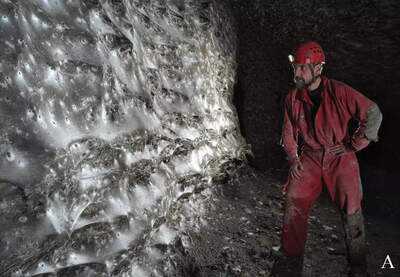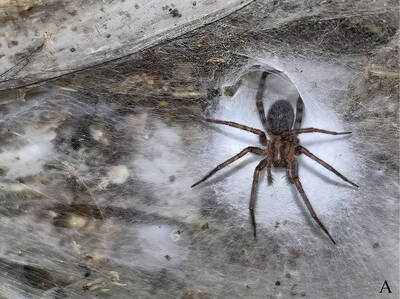In an astonishing discovery, scientists have found what is believed to be the world’s largest spiderweb inside Sulfur Cave , a dark and narrow passage located on the border between Greece and Albania. This extraordinary web, sprawling over a massive 106 square meters (1,140 square feet), is home to an estimated 111,000 spiders living together in an unprecedented colonial network.
The web, first discovered by cavers from the Czech Speleological Society during a 2022 expedition in Vromoner Canyon, is a remarkable patchwork of thousands of individual funnel-shaped webs clinging to the cave walls. A team of researchers led by István Urák from the Sapientia Hungarian University of Transylvania in Romania visited the cave in 2024 to study this extraordinary arachnid colony.
The colony comprises two dominant species: about 69,000 individuals of Tegenaria domestica, commonly known as the barn funnel weaver or domestic house spider , alongside more than 42,000 Prinerigone vagans, a type of sheet weaver spider. This is the first documented instance of these two common species exhibiting cooperative colonial behavior instead of their usual solitary or predatory interactions.
Spiderweb discovery reveals massive spider colonies : In photos



Sulfur Cave spiders thrive in a unique Sulfur-powered ecosystem
According to the researchers, the absence of light within Sulfur Cave appears to have altered normal spider behaviors, potentially disrupting predatory instincts and allowing these species to coexist in such high densities. The cave environment is uniquely sustained by a sulfur-rich stream flowing through the cavern, producing hydrogen sulfide that supports a sulfur-based microbial biofilm ecosystem.
The spiders’ primary diet consists of non-biting midges, which feed on these microbial films, creating a fascinating sulfur-driven food web that sustains the massive spider colony. This cave ecosystem is unlike any other, as molecular and gut content analyses reveal that the cave-dwelling spiders have genetically diverged from their surface relatives and possess less diverse microbiomes due to their sulphur-based diet.
The cave is also a hotspot for reproduction, with female house spiders known to lay six to eight egg sacs every 20 to 25 days, each containing up to 100 eggs in the first cocoon, followed by smaller successive clutches. The density of the webs makes it impossible to count all the egg sacs precisely.
“The moment of discovery inspired admiration, respect, and gratitude,” said lead author Urák, emphasizing the uniqueness and ecological importance of this find. The research team is now preparing for further studies to better understand the web’s ecology and the adaptations of its arachnid inhabitants. Conservation of this site remains a priority, given its fragile and isolated nature.
This groundbreaking discovery sheds light on how species adapt within extreme environments and reveals a hidden biodiversity hotspot demonstrating remarkable biological cooperation and survival.
The web, first discovered by cavers from the Czech Speleological Society during a 2022 expedition in Vromoner Canyon, is a remarkable patchwork of thousands of individual funnel-shaped webs clinging to the cave walls. A team of researchers led by István Urák from the Sapientia Hungarian University of Transylvania in Romania visited the cave in 2024 to study this extraordinary arachnid colony.
The colony comprises two dominant species: about 69,000 individuals of Tegenaria domestica, commonly known as the barn funnel weaver or domestic house spider , alongside more than 42,000 Prinerigone vagans, a type of sheet weaver spider. This is the first documented instance of these two common species exhibiting cooperative colonial behavior instead of their usual solitary or predatory interactions.
Spiderweb discovery reveals massive spider colonies : In photos

Sulfur Cave spiders thrive in a unique Sulfur-powered ecosystem
According to the researchers, the absence of light within Sulfur Cave appears to have altered normal spider behaviors, potentially disrupting predatory instincts and allowing these species to coexist in such high densities. The cave environment is uniquely sustained by a sulfur-rich stream flowing through the cavern, producing hydrogen sulfide that supports a sulfur-based microbial biofilm ecosystem.
The spiders’ primary diet consists of non-biting midges, which feed on these microbial films, creating a fascinating sulfur-driven food web that sustains the massive spider colony. This cave ecosystem is unlike any other, as molecular and gut content analyses reveal that the cave-dwelling spiders have genetically diverged from their surface relatives and possess less diverse microbiomes due to their sulphur-based diet.
The cave is also a hotspot for reproduction, with female house spiders known to lay six to eight egg sacs every 20 to 25 days, each containing up to 100 eggs in the first cocoon, followed by smaller successive clutches. The density of the webs makes it impossible to count all the egg sacs precisely.
“The moment of discovery inspired admiration, respect, and gratitude,” said lead author Urák, emphasizing the uniqueness and ecological importance of this find. The research team is now preparing for further studies to better understand the web’s ecology and the adaptations of its arachnid inhabitants. Conservation of this site remains a priority, given its fragile and isolated nature.
This groundbreaking discovery sheds light on how species adapt within extreme environments and reveals a hidden biodiversity hotspot demonstrating remarkable biological cooperation and survival.
You may also like

John Wesley Ryles dead: Tributes pour in as beloved country music star dies

J-K: Indian army celebrates Guru Nanak Jayanti 2025 in remote areas of Kathua

Seafood exporters seek market diversification, value addition amid US tariff blow

Anemone review: Daniel Day-Lewis stuns as traumatised veteran in long-awaited return

Raised in India's pluralistic embrace, next Dalai Lama would uphold tradition and global conscience: Report







